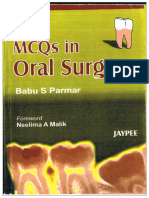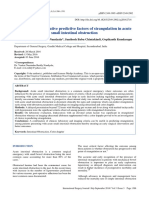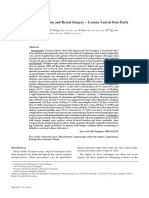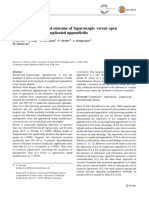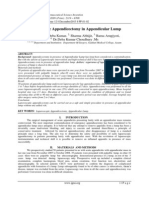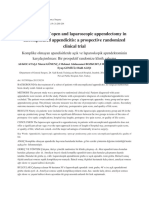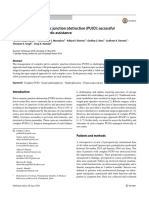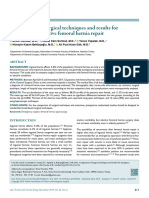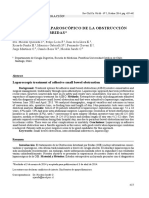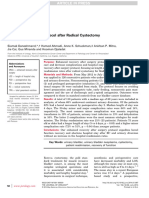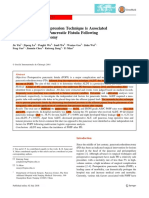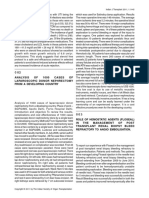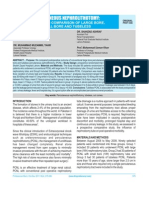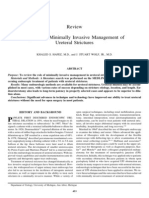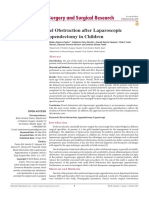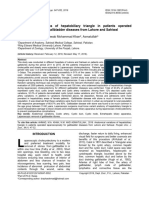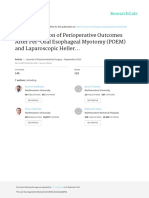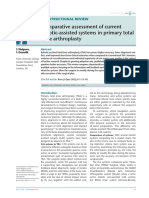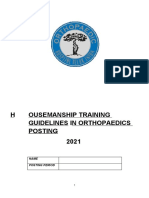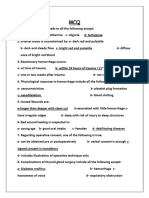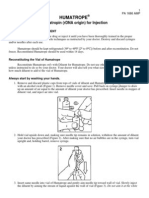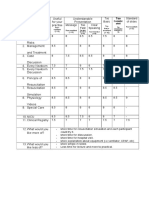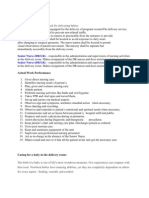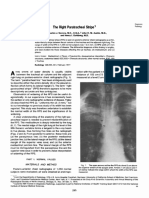Khan
Khan
Uploaded by
Nguyễn Văn KhoaCopyright:
Available Formats
Khan
Khan
Uploaded by
Nguyễn Văn KhoaCopyright
Available Formats
Share this document
Did you find this document useful?
Is this content inappropriate?
Copyright:
Available Formats
Khan
Khan
Uploaded by
Nguyễn Văn KhoaCopyright:
Available Formats
Md.
Rokonuzzaman Khan et al
OUTCOME OF LAPAROSCOPIC VERSUS OPEN
PYELOPLASTY IN THE TREATMENT OF PELVIURETERIC
JUNCTION OBSTRUCTION: A COMPARATIVE STUDY.
MD. ROKONUZZAMAN KHAN1, MD. FAZAL NASER2, MD. MIZANUR RAHMAN3, MEHBUBA YASMIN4,
MD. MOSTAFIZUR RAHMAN5, MD. MUAZZAM HOSSAN6
Abstract
Background: Ureteropelvic junction obstruction leads to progressive dilatation of the
renal collecting system, and can result in pain and progressive deterioration of renal
function but may be asymptomatic and result in complication such as
pyelonephritis,calculus formation and deterioration of renal function may ensue if left
untreated.Open pyeloplasty remains the gold standard against which new technique
must be compared.we compared laparoscopic and open pyeloplasty in the treatment of
pelviureteric junction obstruction. To see the outcome of laparoscopic pyeloplasty versus
open A-H pyeloplasty in the management of pelviureteric junction obstruction.
Methods and materials: A prospective quasi experimental study was done from july
2012 to December 2013 in which a total of 30 laparoscopic and 30 open pyeloplasty
were done. All laparoscopic pyeloplasties were performed transperitoneally.Standard
open A H pyeloplasty,spiral flap or VY plasty was done depending on anatomical
consideration. Patients were followed with USG and IVU at three and six months
interval.Perioperative parameters including operative time,analgesic use,hospital stay,and
complication and success rates were compared.
Results: Mean total operative time in LP group was 115±15 min compared to 75 ±15 in
OP group, the postoperative analgesic requirement was sighnificantly less in LP
group(mean 84.73±11mg) and OP group required mean of( 274.33±39.42mg).The mean
blood loss in LP group was 118.26±110.74ml compared to open group
274.82±118.97ml.The postoperative hospital stay in LP was mean 4 days(2-7days)
sighnificantly less than the open group mean of 8 days(7-9days).
Conclusion: Lp has a minimal level of morbidity and short hospital stay compered to
open approach.Although laparoscopic pyeloplasty has the disadvantages of longer
operetive time and requires sighnificant skill of intracorporal knotting but it is here to stay
and represents an emerging standard of care.
Bangladesh J. Urol. 2019; 22(2):
1. Assistant Professor of Urology, MA Rahim Medical College Introduction
Hospital, Dinajpur Pelviureteric junction obstruction leads to progressive
2. Associate Professor of Urology Shaheed Suhrawardy Medical
dilatation of the renal collection system,and can result
College Hospital
3. Professor of Urology, Dhaka Medical College & Hospital DMCH. in pain and progressive deterioration of renal function
4. OSD, DGHS, Dhaka. but may be asymptomatic and result in complications
5. Assistant Professor of Urology, Khwaja Yunus Ali Medical such as pyelonephritis,calculus formation and renal
College, Sirajgonj
failure.Most cases are congenital in origin and most
6. Assistant Professor of Urology, Abu Naser Specialist Hospital,
Khulna. were detected before birth by prenatal
Address of correspondence: Assistant Professor of Urology, MA ultrasonography.Children who escape diagnosis in
Rahim Medical College Hospital, Dinajpur, Mobile: 01728137925, infancy can present later in life.Most common in boys
Email: dr.rokon77@gmail.com
than girls(5:2) and more common in left side(5:2) and
Received: 05 February 2019 Accepted: 10 May 2019 contralateral PUJ obstruction(10%).Most common
182 Bangladesh J. Urol. 2019; 22(1): 182-187
22(2) 2019
183
Outcome of Laparoscopic versus open pyeloplasty in the treatment of pelviureteric junction obstruction: A Comparative study.
causes are intrinsic muscular defect,abnormal collagen complications,length of hospital stay, postoperative pain
tissue deposition in and around muscular fibre and return to normal activity, and radiographic outcome
cell,aberrant blood vessels and congenital narrowing at 3 months and 6 months (Bansalet al,2013).
etc.Surgical management of PUJO aims to provide
symptomatic relief and preserve remaining renal Material and methods
function.Common surgical treatment of pelviureteric A prospective randomized study was done from July
junction obstruction consists of open surgical Andersen- 2012 to december2013 in which a total of 30
Hynes pyeloplasty,laparoscopic approaches,and laparoscopic and 30 open pyeloplasty were done.All
endourologic methods,(Carr2002). procedure were perfomed in Dhaka medical college and
hospital and other private hospital in Dhaka city.In this
Open pyeloplasty has been the gold standard for surgical prospective study, sixty consecutive patients were
treatment of ureteropelvic junction obstruction,enjoining selected as per selection criteria from the patients
a long term success rate exceeding90%.This procedure attending in the out patient department of urology
requires a muscle cutting incision that entails some degree unit,Dhaka medical college hospital and other private
of morbidity. The optimum surgical correction of UPJO medical college and hospital,Dhaka.With the complaints
has been a urological challenge for over a century.Open of flank pain, flank or abdominal mass,recurrent fever
pyeloplasty originally described by Andersen and Hynes with lower urinary tract symptoms etc. The patients with
remains the gold standard against which new technique above mentioned complaints were evaluated first by
must be compared.The morbidity associated with flank details history, physical examination and investigation
incision,however, has led to development of minimally by urinalysis, urine culture and sensitivity,complete blood
invasive approachs to UPJ repair.Over the last two count,Blood urea nitrogen,serum creatinine and
decades the treatment approach to UPJ obstruction has ultrasonography of KUB region.Then suspected cases
evolved from open pyeloplasty to various minimally of PUJ obstruction were further evaluated by intravenous
invasive procedures like endopyelotomy,balloon dilatation urography and diuretic DTPA renography as out patients
and laparoscopic pyeloplasty.These minimally invasive basis.Then the patients with PUJ obstruction who fulfilled
options are reported to be less successful than open the selection criteria included in this study and admitted
pyeloplasty.Laparoscopic pyeloplasty was described first in the urology ward and numbered chronologically.Out
in 1993 by schuessler et al.Laparoscopic pyeloplasty has of the 30 patients for laparoscopy 25 presented with pain
developed worldwide as the first minimally invasive option and five presented with recurrent urinary tract
to match success rate of open pyeloplasty.only one infection.Thirty patients had pain in open pyeloplasty
randomized study to compare laparoscopic and open group while three presented with lump and one patient
pyeloplasty has been done by turk et al in 2002.In this presented with haematuria after minor trauma.All
prospective study, we see the outcome of transperitoneal patients underwent cystoscopy and RGP to comfirm the
laparoscopic pyeloplasty and open A-H pyeloplasty using diagnosis before the procedure.Urethral catheter was
a minimal flank incision with regard to operative left in situ.
Dissection of crossing vessels Holding suture through abdominal wall
Bangladesh J. Urol. 2019; 22(2): 182-187 183
Md. Rokonuzzaman Khan et al
1. Division of ureteropelvic junction 2. Lateral speculation of ureter 3. Suturing
All laparoscopic pyeloplasty were performed condition.A total 30 Laparoscopic pyeloplasty and 30
transperitonealy.Patients were placed in lateral kidney patients Open pyeloplasties were performed.Mean total
position. Three trocers were placed to enable operative time with stent placement in LP group was
dissection,retraction and identification of 115 ±15 min compared to 75 ±15 min in open group (p
PUJO.Depending on the anatomical findings at time <0.05).Total operative time did improved with
of dissection dismembered or non dismembered experience for LP patients.There was no blood
procedures were performed.In case of redundant pelvis transfusion in any patient.The mean blood loss in LP
reduction pyeloplasty was performed.Anatomoses were group was 118.26 ±110.74ml.compoared to
done with 4-0 polyglactin.After completion of posterior 274.82 ±118.97ml.in open group (p <0.05).There was
layer DJ stent was placed and then anatomosis was no mortality in either group.
completed.Drain tube was inserted adjacent to repair Compare to open pyeloplasty, the mean pain score in
and Foleys cather was left in the bladder for five first 24 hours following pyeloplasty was 13.48±2.7.In open
days.Drain was removed the fourth day if the drain group the mean pain score was 23.05±2.8 (p <0.05).
output did not increase.Internal stent was removed after Intensity of pain in first 24 hours following pyeloplasty was
the fourth week. All patients were followed with USG sighnificantly less in laparoscopic pyeloploasty group.
and IVU at 3 months and 6 months and then annully. postoperative pethedine requirement was sighnificantly
Perioperative parameters including operative less in LP group(mean 84.73±11.63mg) compared to open
time,analgesic use,hospital stay,and complication and group( mean 274.33±39.42mg).The duration of analgesic
success rate were compared.The success was defined requirement was also sighnificantly less in LP group.The
radiologically as a patent, unobstructed UPJ or postoperative hospital stay in LP was mean 3.14days(2-
improved or maintained renal function status and 7days) sighnificantly less than open group mean
symptomatic improvement. 8.29days(7-11days) (p <0.05). There was only one major
complication in laparoscopic group.That patients had
Result: prolonged drainage of urine(6 days) through the drain
The demographics of two groups were similar with which subsided with prolonged catherization.No patients
regard to sex, age.None had any significant co-morbid in open group had any complication.
Table-I
Preoperative and postoperative characteristics of the study patients.
Variables Laparoscopic Group Open Group P value
Operative time (min) (mean ± SD) 115 ± 15 75 ± 15 0.00011
Peroperative blood loss (ml) (mean ± SD) 118.26 ± 110 274.82 ±118.97 0.00011
Pain score (mean ± SD) 13.48 ± 2.7 23.05 ± 2.8 0.00011
Postoperative hospital stay (day) (mean ± SD) 3.14 8.29 0.00011
Postoperative complication (%) 3.33 0 0.00012
1Data were analyzed by using Student’s t- test.
2Data were analyzed by using Chi-square test.
184 Bangladesh J. Urol. 2019; 22(1): 182-187
22(2) 2019
185
Outcome of Laparoscopic versus open pyeloplasty in the treatment of pelviureteric junction obstruction: A Comparative study.
Discussion: As laparoscopic surgery becomes more entrenched in
The first successful reconstruction of an obstructed resident training, the more complex skills such as
UPJO was accomplished in 1892.Since then open intracorporal suturing becomes less daunting.
pyeloplasty has been the gold standard for UPJO repair Moreover,Long operative time may be reduced by skill
and achieves success rates excedding 90% in of intracorporal knotting.
comtemporary series.In 1983 wicham and kellet .In present laparoscopic pyeloplasty, mean blood loss
described percutaneous pyelolysis(endopyelotomy) was 118 ±110.74ml.The mean blood loss in open
which subcequently gained some pyeloplasty was 274.82 ±118.97ml.Blood loss was
popularity.Subsequently evolution in endoscopic sighnificantly less in laparoscopic pyeloplasty group.In
physiology and application together with advances in a comparable study, Nihad et al,2011 had seen that
endoscopic technology fostered advances in the field. laparoscopic pyeloplasty had less blood loss,morbidity
Current approachs included antegrade percutaneous and less hospital stay than open pyeloplasty. Pain score
retrograde ureteroscopic guided laser and retrograde in first 24 hours following laparoscopic pyeloplasty was
acusize ballon dilatation.The success rate of these 13.48 ± -2.7.In open pyeloplasty,the mean pain score
minimally invasive options have consistently been less was 23.05 ±2.81.Intensity of pain in first 24 hours
than with open pyeloplasty by 10-30%.The varied following pyeloplasty was sighnificantly less in
surgical anatomy of PUJ (huge dilatation, crossing laparoscopic pyeloplasty group.In a similar comparable
vessels,high insertion of ureter) compromise all of these study,Bansal et al,2013 had compared to open
endourological procedures.These procedures are also pyeloplasty group with laparoscopic and it was revealed
associated with a risk of perioperative haemorrage and that the post operative analgesics requirement was
3-11% patients required blood transfusion. sighnificantly less in LP group.In a recent study
Laparoscopic pyeloplasty provides a minimally invasive Falahatkar et al,2012 observed that the mean dosage
alternative to repair UPJO.Laparoscopic pyeloplasty of postoperative analgesics and complication rates in
was introduced in 1993 by schussller et al and has laparoscopic (26,25mg;23.8%) were lower than open
developed worldwide as the first minimally option to pyeloplasty(38.33mg; 36%).In present study,pethedine
match success rate of open pyeloplasty.Reconstruction requirement in laparoscopic pyeloplasty was
of UPJO can be tailored to anatomical findings at the 84.73 (±)11.63mg for post operative pain
time of surgery.The feasibility of laparoscopic management.The mean pethedine requirement in open
pyeloplasty including Andersen-hynes,Fengers,Foleys A-H pyeloplasty was 274.33 ±39.42mg.Pethedine
VY plasty performed through transperitoneal and requirement was sighnificantly less in laparoscopic
retroperitoneal approach has been evaluated. Its pyeloplasty group(p<0.05).
potential advantages including less peroperative There is very small incision and tissue trauma during
bleeding, less postoperative pain,shorter hospital stay laparoscopy.So,patient can be discharged early than
and improved cosmesis have been proved.The only open surgery.Falahatkar et al,2012 revealed in their
disadvantage seems to be longer operative time.zhang study that the mean postoperative hospital
et al reported less operative time in laparoscopic group stay(LP:4.6 ±1.76 days;OP:4.3 ±1.55 days;p=0.934)
than open group.Bansal et al,2013 observed that total were similar between the two groups.In laparoscopic
operative time with stent placement in laparoscopic pyeloplasty,the mean hospital stay was 4±1 days for
pyeloplasty group was 244.2(280-300min) compared PUJ obstruction.In open pyeloplasty group,mean
to 122min (100-140min) in open pyeloplasty hospital stay was 8±2 days.Hospital stay was
group.Falahatkar et al,2012 revealed that laparoscopic sighnificantly shorter in laparoscopic pyeloplasty
pyeloplasty (28 ±095min) had a sighnificantly (p=0.003) group.It was seen that urine leakage was more in case
higher mean operating time than open (204 ±59 of laparoscopic pyeloplasty which might be due to
min)one.Nihad AA(2011) revealed that the main ligature and knotting during procedure.In open A-H
disadvantage of laparoscopic pyeloplasty was the pyeloplasty, there was more tissue handling to
longer operative time. In our study, mean operative time increased incidence of wound infection compared to
in laparoscopic pyeloplasty was 115 ±15minutes.The laparoscopic one.In present study it was revealed that
mean operative time in open pyeloplasty was 75 ±15 post operative complications were sighnificantly less
min. Operative time was sighnificantly longer in in laparoscopic pyeloplasty group except urine leakage
laparoscopic pyeloplasty group like previous studies. which was more in laparoscopic pyeloplasty.
Bangladesh J. Urol. 2019; 22(2): 182-187 185
Md. Rokonuzzaman Khan et al
If any difficulty like failure to find out renal pelvis or 6. Chen RN, Moore RG,Kavoussi LR,1998,
’Laparoscopic pyeloplasty.Indication, technique,
malrotated pelvis,and severe adhesion,laparoscopic
pyeloplasty converted into open one.In present and long term outcome’, vol.25(20,pp.323-330.
study,two (6,67%) laparoscopic patients were converted 7. Chertin B,RolleU,Farkas A,Puri P 2002,’ Does
to open pyeloplasty.Klinger et al,2003 found two delaying pyeloplasty after renal function in children
patients with laparoscopic pyeloplasty required open with a prenatal diagnosis of pelviureteric junction
pyeloplasty during operation among 40 subjects. obstruction?’,BJU int,vol.90,pp.72-75.
In general,the reported overall complications rate of 8. Conford PA,Rickward AM.1998, Function results
laparoscopic pyeloplasty range from 3% -14%.The of pyeloplasty in patients with ante-natally
success rate of laparoscopic pyeloplasty has been diagnosed pelviureteric junction
reported to be consistently high at 87-98%. In the ’
obstruction ,BJU,vol.81(1),pp.152-156.
present series, we had a success rate of 93%. We 9. Danielle D,Sweeney,MD,Michael C.Ost,MD,
considered conversion to open as a failure. Francih X. Schneck,MD,and Steven G. Docimo,
MD 2011,Laparoscopic pyeloplasty for
Conclusion
ureteropelvic junction obstruction in children’,
The result of this study showed that laparoscopic
Journal of laparoendoscopy and advanced
pyeloplasty is a safe procedure for management of PUJ
surgical techniques,vol.21,pp.261-265.
obstruction.Laparoscopic pyeloplasty has a minimal
level of morbidity and short hospital stay compared to 10. Falahatkar S,Roushani A,Nasseh H,
open approach.Although,laparoscopic pyeloplasty has Kazemnezhad E,Moghaddam KG,Raoofi SM,Asi
the disadvantages of longer operative time and requires MM,Enshaei A,Farzan A 2012,’ Pyeloplasty in
Ureteropelvic junction obstruction:laparoscopic or
sighnificant skill of intracorporeal knotting .It represents
open?’ UroToday INT J,vol.5(4),pp.10-19.
an emerging standard of management for pelviureteric
junction obstruction. 11. Hensle TW,Kirsh AJ 1996, The correction of
uteropelvic junction obstruction. In text Book of
References Operative Urology,Editor:masshall FF,Ed 1st,WB
1. Anderson JC Hynes W 1949,Retro-caval ureter: Saunders,Philadelphia,pp.824-831.
A case diagnosed preoperatively and treated
12. Jarrett TW,Chan DY,Charambura TC, Fugita O,
successfully by a plastic operation’,Br J
Kavoussi LR 2004,’Laparoscopic pyeloplasty.The
Urol.,Vol.21,pp.209-214.
first 100 cases’,J urol.2004;vol.167,pp.1253-1256.
2. Bansal P,Gupta A,Mongha R,Narayan S,Kundu
13. Kavoussi LR,Peters CA 1993,’ Laparoscopic
AK, Chakraborty SC,Das RK,Bera MK.2013,’
pyeloplasty’,J urol.,vol.150,pp.1891-1899.
Laparoscopic versus open pyeloplasty:
Comparison of two surgical approaches-a single 14. Kletscher BA, Segura JW,LeRoy AJ 1995,
centre experience of three years’,J Minim access Percutaneous antegrade endoscopic pyelotomy:
surg,Vol.9(4),pp.148-155. review of 60 cases’,J urol, vol.153, pp.701-703.
3. Bonnard A,Fouquet V, Carricaburu E,Aigrain Y,El- 15. Klingler HC, Remzi M,Janetschek G, Kratsik c,
Ghoneimi 2005,’A retroperitoneal laparoscopic Marberger MJ 2003,’Comparison of open versus
versus open pyeloplasty in children ’ ,J laparoscopic pyeloplasty techniques in treatment
urol.,vol.173,pp.1710-1713. of ureteropelvic junction obstruction’,Eur Urol.
4. Brooks JD, Kavoussi LR,Preminger GM ,vol.44(3)pp.340-345.
1995,’Comparison of open and endourological 16. Klingler HC,Remzi M,Janetschek C,Kratzik
approaches to the obstructed ureteropelvic C,Marberger MJ 2003,’Comparison of open
junction’, Urology,vol.46(6),pp.791-795. versus laparoscopic pyeloplasty techniques in
treatment of ureteropelvic junction obstruction’,Eur
5. Carr MC.2002, ‘Anomalies and surgery of the
urol,vol.44,pp.340-345.
ureteropelvic junction in children.In:
PC’,Campbell’s Urology.8th ed.Philadelphia,WB 17. Koff SA,Wise II HA 1994, ’The nonoperative
saunder. management of unilateral neonatal hydro-
186 Bangladesh J. Urol. 2019; 22(1): 182-187
22(2) 2019
187
Outcome of Laparoscopic versus open pyeloplasty in the treatment of pelviureteric junction obstruction: A Comparative study.
nephrosis:natural history of poorly functioning 27. Salem YH,Rushton HG,Belmon AB
kidneys’,J Urol.,vol.152,pp.593-595. 1995,’Outcome analysis of paediatric pyeloplasty
as a function of patient age,presentation and
18. Lowe FC,Marshall FF,1984.’Ureteropelvic junction
obstruction in adults’,Urology,vol.24,pp.33. differential renal function’,J Urol,vol.154,pp.1889-
1893.
19. Mayor G,Genton N,Torrando A,Guignard J 1975,
‘Renal function in obstruction nephropathy:Long- 28. Schuessler Ww, Grune MT, Tecuanhuey LV
term effect of reconstructive surgery ’ , 2001,’laparoscopic dismembered pyeloplasty’,J
Paediatrics,vol.56,pp.740-743. urol,vol.150,pp.1795
20. McAleer IM,Kaplan GW 1999,’Renal function 29. Soulie M, Thoulouzan M,Seguin P,Mouly
before and after pyeloplasty:does it P,Vazzoler N,Pontonnier F 2001,’Retroperitoneal
improve?’,JUROL,vol.162,pp.1041-1044. laparoscopic versus open pyeloplasty with a
minimal incision:comparison of two surgical
21. Nihad AA 2011, ’ laparoscopic vs open
approaches’,Urology,vol.57,pp.443-467.
pyeloplasty ’ ,World journal of laparoscopic
surgery,vol.4(3),pp.146-150. 30. Stephanie J, Symons M.D.,and Mahesh R.
Desai,M.D 2009, ‘Laparoscopic pyeloplasty:our
22. O’Reilly PH,Brooman PJ,mak S 2001,’The long
new gold standard,Journal of endourology’,
trem results of Anderson Hynes
pyeloplasty’,BJU,vol57(40,pp.287-289. vol.23,pp.463-467.
23. Singh O Gupta SS,Hastir A,Arvind NK 31. Troxel S, Das S,Helfer E,Nugyen M 2006,
‘ laparoscopic versus dorsal Lumbotomy for
2010,’Laparoscopic dismembered pyeloplasty for
ureteropelvic junction obstruction ’,Journal of ureteropelvic junction obstruction repair ’, J
endourology,vol.24,pp.1431-1434. Urol,vol.176(3),pp.1073-1076.
24. Poulsen EU,Jorgensen TM,Jensen FT,djurhuus 32. Turk IA,Davis JW, Winkelmann B,Deger S,
JC 1‘987,’The functional outcome of Anderson- Richter F, Fabrizio MD, et al.2200. ‘laparoscopic
hynes pyeloplasty for hydronephrosis’,Scand J I dismembered pyeloplasty-the method of choice
Urol Nephrol,vol,21,pp.213-217. in the presence of an enlarged renal pelvis and
crossing vessels’,Eur Urol, vol.42;,pp.268-275.
25. Roth DR,Gonzales ET 1983,’Management of
ureteropelvic junction obstruction in infancy’,J 33. Vaughan ED JR, Sodrenson EJ,Gillenwater JY
Urol,vol.129,pp.108-111. 1970, The renal hemodynamic response to
26. Salamony TM,Riad EM,Esmat ME,Zaky chronic unilateral complete ureteral
AM,Zayed AS,Galal HA,et al 2006,’laparoscopic occlsion’,Invest Urol, vol.8pp.358-363.
pyeloplasty preliminary experience in theodor 34. Zaid Z, Samad L, Aquil S 2007, ‘Laparoscopic
Bilharz Research institute’,Egyptian Journal of pyeloplasty:Technique and outcome’J Pak Med
surgery,vol.25(10.pp.46-52. Assoc,vol.57(7)pp.355-359.
Bangladesh J. Urol. 2019; 22(2): 182-187 187
You might also like
- MCQs in Oral Surgery by Babu SParmarDocument517 pagesMCQs in Oral Surgery by Babu SParmarAmr KhattabNo ratings yet
- A Study of Preoperative Predictive Factors of Strangulation in Acute Small Intestinal ObstructionDocument6 pagesA Study of Preoperative Predictive Factors of Strangulation in Acute Small Intestinal ObstructionSantosh BabuNo ratings yet
- (Final Edit) Ventral Onlay Buccal Graft For Urethrorectal FistulaDocument13 pages(Final Edit) Ventral Onlay Buccal Graft For Urethrorectal FistulaNadia Rezky ElizaNo ratings yet
- 1 Bjs 10662Document8 pages1 Bjs 10662Vu Duy KienNo ratings yet
- Abstracts / Pancreatology 19 (2019) S1 Es180 S30Document1 pageAbstracts / Pancreatology 19 (2019) S1 Es180 S30Hưng Nguyễn KiềuNo ratings yet
- Bun V34N3p223Document6 pagesBun V34N3p223pingusNo ratings yet
- Laparoscopic Peptic Ulcer Perforation Closure: The Preferred ChoiceDocument5 pagesLaparoscopic Peptic Ulcer Perforation Closure: The Preferred ChoiceHanny FadhilaNo ratings yet
- A Prospective Comparativestudy of Open Versus Laparoscopic Appendectomy: A Single Unit StudyDocument8 pagesA Prospective Comparativestudy of Open Versus Laparoscopic Appendectomy: A Single Unit StudyIJAR JOURNALNo ratings yet
- Complicated AppendicitisDocument4 pagesComplicated AppendicitisMedardo ApoloNo ratings yet
- A Comparative Study On The Efficacy of RetroperitoneoscopicDocument7 pagesA Comparative Study On The Efficacy of RetroperitoneoscopicNguyễn Văn KhoaNo ratings yet
- Early Complications Followoing Laparoscopic Cholecystectomy in Basrah General HospitalDocument15 pagesEarly Complications Followoing Laparoscopic Cholecystectomy in Basrah General HospitalBurhan SabirNo ratings yet
- Laproscopic Vagotony PaperDocument4 pagesLaproscopic Vagotony Paperpeter_mrNo ratings yet
- Apendisitis MRM 3Document8 pagesApendisitis MRM 3siti solikhaNo ratings yet
- 11228-Article Text-39349-1-10-20141009 PDFDocument5 pages11228-Article Text-39349-1-10-20141009 PDFsahandNo ratings yet
- Management of Ruptured Liver Abscess: A Study of 54 CasesDocument4 pagesManagement of Ruptured Liver Abscess: A Study of 54 CasesIndah FebrianaNo ratings yet
- Isj-5899 oDocument5 pagesIsj-5899 oAbhiram MundleNo ratings yet
- Jurnal 3 AppDocument4 pagesJurnal 3 AppmaulidaangrainiNo ratings yet
- Laparoscopic Appendicectomy in Appendicular LumpDocument2 pagesLaparoscopic Appendicectomy in Appendicular LumpinventionjournalsNo ratings yet
- A Prospective Treatment Protocol For Outpatient Laparoscopic Appendectomy For Acute AppendicitisDocument5 pagesA Prospective Treatment Protocol For Outpatient Laparoscopic Appendectomy For Acute AppendicitisBenjamin PaulinNo ratings yet
- Posterior Sagittal Anorectoplasty in Anorectal MalformationsDocument5 pagesPosterior Sagittal Anorectoplasty in Anorectal MalformationsmustikaarumNo ratings yet
- Outcomes Hjs BdiDocument11 pagesOutcomes Hjs BdiJade cNo ratings yet
- 268 2011 Article 1088 PDFDocument6 pages268 2011 Article 1088 PDFIoel Tovar TrovaNo ratings yet
- Is 9Document9 pagesIs 9intan juitaNo ratings yet
- Complex Pujo PDFDocument7 pagesComplex Pujo PDFAnjit PhuyalNo ratings yet
- Versus: Laparoscopic Open Appendectomy: Which Way To Go?Document6 pagesVersus: Laparoscopic Open Appendectomy: Which Way To Go?Claudiu Ungureanu ClauNo ratings yet
- KumarDocument6 pagesKumarNguyễn Văn KhoaNo ratings yet
- Utd 04524 Clinical - Article KunduzDocument5 pagesUtd 04524 Clinical - Article Kunduzzenatihanen123No ratings yet
- Surgical ResearchDocument6 pagesSurgical ResearchScivision PublishersNo ratings yet
- 56. lee2007Document6 pages56. lee2007Sơn Lê ThếNo ratings yet
- Open Versus Laparoscopic Cholecystectomy A ComparaDocument5 pagesOpen Versus Laparoscopic Cholecystectomy A ComparaChintya EltaNo ratings yet
- Bess Is Sow 2014Document2 pagesBess Is Sow 2014Alfredo ChoquetNo ratings yet
- A Non-Operative Treatment of Perforated Peptic Ulcer: A Prospective Study With 50 CasesDocument4 pagesA Non-Operative Treatment of Perforated Peptic Ulcer: A Prospective Study With 50 CasesSake Cinema21No ratings yet
- Art07 PDFDocument6 pagesArt07 PDFadan2010No ratings yet
- Daneshmand 2014Document7 pagesDaneshmand 2014granmarado10No ratings yet
- Laparoscopic Versus Open Appendicectomy: A Comparative StudyDocument7 pagesLaparoscopic Versus Open Appendicectomy: A Comparative StudyChristianWicaksonoNo ratings yet
- Better Orchiopexy and High Ligation 2016Document4 pagesBetter Orchiopexy and High Ligation 2016Richard QiuNo ratings yet
- Afferent Loop Decompression Technique Is Associated With A Reduction in Pancreatic Fistula Following PancreaticoduodenectomyDocument10 pagesAfferent Loop Decompression Technique Is Associated With A Reduction in Pancreatic Fistula Following PancreaticoduodenectomyDrDipesh Kumar YadavNo ratings yet
- Retrospective Study To Determine The Short-Term Outcomes of A Modified Pneumovesical Glenn-Anderson Procedure For Treating Primary Obstructing Megaureter. 2015Document6 pagesRetrospective Study To Determine The Short-Term Outcomes of A Modified Pneumovesical Glenn-Anderson Procedure For Treating Primary Obstructing Megaureter. 2015Paz MoncayoNo ratings yet
- 2. laparoscopie versus open colorectal surgeryDocument9 pages2. laparoscopie versus open colorectal surgeryhounsourenstephNo ratings yet
- Liver Abscess: Catheter Drainage V/s Needle AspirationDocument6 pagesLiver Abscess: Catheter Drainage V/s Needle AspirationMishel Rodriguez GuzmanNo ratings yet
- 78. kumar2011Document1 page78. kumar2011Sơn Lê ThếNo ratings yet
- Choledochal Cysts in Children: How To Diagnose and Operate OnDocument6 pagesCholedochal Cysts in Children: How To Diagnose and Operate OnRegita SiskaNo ratings yet
- Prospective & Comparative Study of Various Techniques Used in The Management of Liver Abscess in The Bundelkhand AreaDocument10 pagesProspective & Comparative Study of Various Techniques Used in The Management of Liver Abscess in The Bundelkhand AreaIJAR JOURNALNo ratings yet
- Evaluation of Post-Operative Dysphagia Following ADocument12 pagesEvaluation of Post-Operative Dysphagia Following Adisaac3796No ratings yet
- Percutaneous Nephrolithotomy : Randomized Comparison of Large Bore, Small Bore and TubelessDocument6 pagesPercutaneous Nephrolithotomy : Randomized Comparison of Large Bore, Small Bore and TubelessAmir Akram MasihNo ratings yet
- Reoperative Antireflux Surgery For Failed Fundoplication: An Analysis of Outcomes in 275 PatientsDocument8 pagesReoperative Antireflux Surgery For Failed Fundoplication: An Analysis of Outcomes in 275 PatientsDiego Andres VasquezNo ratings yet
- DFGHJKDocument3 pagesDFGHJKcliffwinskyNo ratings yet
- The Incidence and Risk of Early Postoperative Small Bowel Obstruction After Laparoscopic Resection For Colorectal Cancer 2014Document7 pagesThe Incidence and Risk of Early Postoperative Small Bowel Obstruction After Laparoscopic Resection For Colorectal Cancer 2014alemago90No ratings yet
- Review StrikturDocument13 pagesReview StrikturFryda 'buona' YantiNo ratings yet
- @medicinejournal European Journal of Pediatric Surgery January 2020Document126 pages@medicinejournal European Journal of Pediatric Surgery January 2020Ricardo Uzcategui ArreguiNo ratings yet
- Kurum Boor 2016Document4 pagesKurum Boor 2016Chema ToledoNo ratings yet
- Journal AppDocument3 pagesJournal AppliqqamuqitaNo ratings yet
- Editorial: Percutaneous Drainage of Liver Hydatid Cysts: Is Evidence Enough To Accept It As First Modality of Choice?Document3 pagesEditorial: Percutaneous Drainage of Liver Hydatid Cysts: Is Evidence Enough To Accept It As First Modality of Choice?David CerrónNo ratings yet
- Clinical Study and Management of Pseudocyst of Pancreas: Original Research ArticleDocument5 pagesClinical Study and Management of Pseudocyst of Pancreas: Original Research Articleneel patelNo ratings yet
- Laparoscopic Ventral Hernia Repair With Tacker Only Mesh Fixation: Single Centre ExperienceDocument5 pagesLaparoscopic Ventral Hernia Repair With Tacker Only Mesh Fixation: Single Centre ExperienceMudassar SattarNo ratings yet
- 8-Anatomical V31 1 2016Document6 pages8-Anatomical V31 1 2016DrSaabNo ratings yet
- 01 HepatogastroDocument3 pages01 Hepatogastroyacine26No ratings yet
- Conservative Management of Perforated Peptic UlcerDocument4 pagesConservative Management of Perforated Peptic UlcerAfiani JannahNo ratings yet
- 683 Comparison of Perioperative Outcomes After PerDocument9 pages683 Comparison of Perioperative Outcomes After PerVidro Alif GunawanNo ratings yet
- Laparoscopic Vs Open Appendectomy: Which Way To Go?Document22 pagesLaparoscopic Vs Open Appendectomy: Which Way To Go?fahryzal_noteNo ratings yet
- Top Trials in Gastroenterology & HepatologyFrom EverandTop Trials in Gastroenterology & HepatologyRating: 4.5 out of 5 stars4.5/5 (7)
- New ListDocument39 pagesNew ListKamal GpNo ratings yet
- Comparative Assessment of Current Robotic-Assisted Systems in Primary Total Knee ArthroplastyDocument6 pagesComparative Assessment of Current Robotic-Assisted Systems in Primary Total Knee ArthroplastyPradiNo ratings yet
- Parotidectomy For Benign Parotid Tumors An AesthetDocument7 pagesParotidectomy For Benign Parotid Tumors An AesthetmerebenefitsNo ratings yet
- Grlinger ROTEM PPH DSMH Colombo 22-01-2019 ShortDocument86 pagesGrlinger ROTEM PPH DSMH Colombo 22-01-2019 ShortDobrila SimonovicNo ratings yet
- Gynecology For Postgraduates, Theory and Practice Autor Mamdouh ShaabanDocument578 pagesGynecology For Postgraduates, Theory and Practice Autor Mamdouh ShaabanbgdNo ratings yet
- Naif SMLE QshareDocument319 pagesNaif SMLE QshareHuzaif KhatibNo ratings yet
- Body Fluids and Circulation SNS 01 (Topic Wise Test 03) - 791 - 1723075662145Document6 pagesBody Fluids and Circulation SNS 01 (Topic Wise Test 03) - 791 - 1723075662145surajsinghpahi2024No ratings yet
- Gallbladder Surgery: Common FAQ & Myths - Kaizen Gastro CareDocument2 pagesGallbladder Surgery: Common FAQ & Myths - Kaizen Gastro CareKaizen Gastro CareNo ratings yet
- Occiput Transverse Position - UpToDateDocument17 pagesOcciput Transverse Position - UpToDateDylanNo ratings yet
- Ho Tagging SheetDocument10 pagesHo Tagging SheetchooNo ratings yet
- MCQ General SurgeryDocument7 pagesMCQ General Surgerysaraabdomena2002No ratings yet
- Humatrope: Somatropin (rDNA Origin) For InjectionDocument3 pagesHumatrope: Somatropin (rDNA Origin) For Injectioneunapim100% (1)
- BurnsDocument9 pagesBurnsVincentus BinNo ratings yet
- Seven Ps For RSI BOARDDocument2 pagesSeven Ps For RSI BOARDJames BrownNo ratings yet
- Pancreatic Cancer Oxford SurgeryDocument10 pagesPancreatic Cancer Oxford SurgeryJose Tomás MooreNo ratings yet
- Poor-Excellent (1-10) Poor-Excellent (1-10) Poor-Excellent (1-10)Document1 pagePoor-Excellent (1-10) Poor-Excellent (1-10) Poor-Excellent (1-10)Dian Sulistya EkaputriNo ratings yet
- Nle 28 June AnswerDocument11 pagesNle 28 June AnswermahedNo ratings yet
- 226-Article Text-421-2-10-20180506 2Document6 pages226-Article Text-421-2-10-20180506 2jt9sh7gfb5No ratings yet
- JDattaMegheInstMedSciUniv162235-4959576 134635Document5 pagesJDattaMegheInstMedSciUniv162235-4959576 134635shyampanga2No ratings yet
- Transport of The Critically Ill Patient PDFDocument4 pagesTransport of The Critically Ill Patient PDFaksinuNo ratings yet
- Gastrointestinal System: Git Brief Introduction: Dr. S. M. A. WaseemDocument20 pagesGastrointestinal System: Git Brief Introduction: Dr. S. M. A. WaseemHoping HeartsNo ratings yet
- Surgical Anatomy of Chest WallDocument31 pagesSurgical Anatomy of Chest WallArockia DharshanaNo ratings yet
- Ovunc Bardakcioglu (Eds.) - Advanced Techniques in Minimally Invasive and Robotic Colorectal Surgery-Springer US (2015)Document256 pagesOvunc Bardakcioglu (Eds.) - Advanced Techniques in Minimally Invasive and Robotic Colorectal Surgery-Springer US (2015)ravikanthNo ratings yet
- Burn Injury BSN 4 Y1 5S Group 1Document23 pagesBurn Injury BSN 4 Y1 5S Group 1ANGELICA MACASONo ratings yet
- Delivery Room,.Document3 pagesDelivery Room,.Yukki CuartoNo ratings yet
- The Right Paratracheal Stripe: Maj. Charles J. Savoca, M.C., U.S.A., John H. M. Austin, M.D., and Henry I. Goldberg, M.DDocument7 pagesThe Right Paratracheal Stripe: Maj. Charles J. Savoca, M.C., U.S.A., John H. M. Austin, M.D., and Henry I. Goldberg, M.DPanakamol PhokaewkulNo ratings yet
- Basic Postoperative Care of The Equ - 2023 - Veterinary Clinics of North AmericaDocument24 pagesBasic Postoperative Care of The Equ - 2023 - Veterinary Clinics of North AmericadiazsunshineNo ratings yet
- Diagnostic and Interventional Nephrology: An Opportunity For Spanish NephrologistsDocument3 pagesDiagnostic and Interventional Nephrology: An Opportunity For Spanish NephrologistsAchrafNo ratings yet
- Perioperative Nursing CA2 PRETESTDocument32 pagesPerioperative Nursing CA2 PRETESTShania Erika Enaje100% (1)
